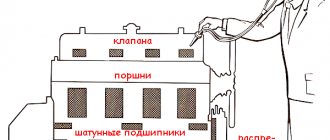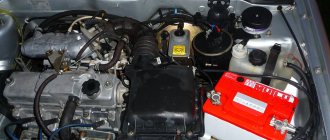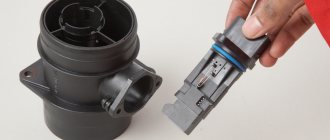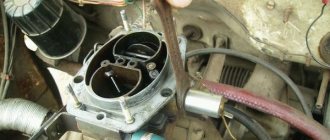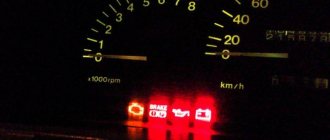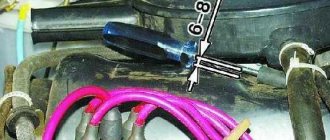Why does the car jerk?
There can be simply a huge number of problems due to which a car can drive jerkily (twitch), and they are individual for each car. These could be problems with the fuel system or transmission problems. Let's look at each of the reasons.
Fuel problems
Problems related to fuel supply to the engine.
Gasoline pump
All cars with injection engines are equipped with a fuel pump that pumps pressure into the fuel system. The normal operating pressure of the pump reaches 10 kg/cm³. Over time, the pump may lose its former power due to aging or dirty filters, fine and coarse fuel cleaning, which will undoubtedly lead to a loss of pressure and improper operation of the internal combustion engine.
Injectors
Another important indicator in the fuel system is the injectors. They spray fuel into the engine cylinder head, mixing it with air and feeding it into the combustion chamber. Over time, the injector nozzle becomes clogged with dirt and carbon deposits, which contributes to incorrect and even insufficient fuel atomization, which leads to uneven operation of the entire internal combustion engine.
Ignition problems
Problems associated with the formation of a spark in the engine.
Candles
To ignite the fuel mixture in a car, spark plugs are used, which produce sparks in the combustion chamber, thereby igniting the air-fuel mixture. Over time, due to the low quality of fuel, which is abundant in the vast expanses of the Russian Federation, spark plugs become covered with soot or, due to exposure to high temperatures, change their gap, which leads to improper operation of the internal combustion engine.
Wires
Spark plug wires also play an important role in engine operation; they transmit high voltage from the coil to the spark plug. The insulation of these wires is made of silicone and, under the influence of high temperatures and time, is subject to drying out and, consequently, cracks. High voltage, passing through a wire with a crack, can make its way to the body and thus does not even reach the spark plug, this is especially noticeable at high speeds and when the car is running under load.
Reels
The ignition module is the element that produces a spark to the cylinders; when it fails, the cylinders fail, but it often happens that the module can turn off due to temperature or load. By the way, the ignition module is no longer available in more modern cars; it was replaced by individual ignition coils, which helped get rid of wires and their problems. The IKZ is put directly on the spark plug and produces a spark for exactly one cylinder in which it is installed.
Transmission problems
Problems related to the gearbox, drives and wheels.
checkpoint
The gearbox is responsible for moving the car. Breakdowns are possible very often, especially if it is a rather complex automatic transmission, in which you have to frequently change the oil and monitor its quality. Failures in the gearbox can be in bearings, shafts, or clutches.
Drive
Car drives or cardans, which transmit rotation from the gearbox to the wheels, can also be the reason why the car jerks. Wear of constant velocity joints can create backlash between the gearbox and the wheel, which will lead to jerking. It’s the same with the cardan transmission, whether it’s on a crosspiece or a CV joint, its wear promises knocks and jerks.
Wheels
Wheels that have uneven wear, namely ellipse, can create jerks on the car when it moves at a certain speed, this is most noticeable on a flat road at a speed of 40 km/h.
Malfunctions of sensor equipment
It is likely that the twitching is caused by a broken sensor. If the ECU is able to detect an anomaly in the readings, the corresponding fault code will be stored in non-volatile memory. The most likely causes of jerking:
- wear of the resistive layer of the throttle position sensors and accelerator pedal. Due to signal loss and contact bounce, the engine ECU is unable to assess the actual load. Most often the car jerks when driving at low gas. During measured driving on the highway and in the city, most of the time the engine is in low and medium load mode, which corresponds to 10-45% throttle opening. Accordingly, the sliding contact of resistive sensors most often moves in this zone, erasing the conductive layer. Therefore, at full throttle, the car can accelerate smoothly, but at the same time jerk in low and partial load mode. You can check the sensors using a diagnostic scanner, observing its readings in real time;
- contamination of the air flow sensor. There is a characteristic jerk when accelerating from first gear. Due to contamination, the sensitivity of the sensor decreases, and at the same time the ability to adequately calculate the amount of air entering the cylinders. On diesel internal combustion engines, the malfunction is accompanied by thick black smoke during gas changes. You can diagnose the health of the sensor by measuring the voltage at its terminals with the ignition on. Using a diagnostic scanner, you can monitor the sensor readings in real time, comparing the actual amount of air with the reference values at different engine operating modes.
Video: Car Jerks When Moving for Several Reasons
Eliminate jerking when accelerating a car
If the VAZ 2106 begins to twitch when accelerating, then in this case it is necessary to carefully check the engine power system. The driver presses the speed pedal while driving, but the vehicle does not accelerate. By pressing the accelerator pedal, the driver provokes an increase in the amount of fuel mixture supplied to the cylinders. If this does not happen, breakdowns occur in a uniform manner.
We check all filters: fuel, air. A carburetor engine has 2-3 filters. We will not take into account the mesh in the neck, since it can only prevent the penetration of large particles. You should carefully check the filter that goes to the fuel pump. Often it becomes clogged with impurities, which ultimately prevents the free flow of fuel, causing the engine to starve.
Air shortage
The air filter is designed to clean the air from road debris, dust and other components that can damage the engine. This element is capable of accumulating dirt to the point of complete obstruction. A clogged filter is the most underrated reason why your car will drive rough due to inefficient fuel combustion.
Another popular reason for a car's abrupt acceleration is the mass air flow sensor. The component performs the task of measuring the amount of intake air and transmitting data to the on-board computer. A defective or dirty sensor causes a loss of engine power and increased fuel consumption.
Oxygen sensors
Most modern car engines are equipped with oxygen sensors (lambda probes). Their number can reach several pieces, depending on the car model. The presence of such a control loop contributes to the smooth and economical operation of the engine. Typically, you can find two types of such sensors:
- Upflow lambda probes. Located inside the exhaust manifold and designed to measure the oxygen level in the vehicle's exhaust gases during the exhaust stroke. Their task is to control incomplete combustion.
- Downflow sensors. Located behind the catalytic converter. They transmit to the computer the information necessary to fine-tune the ratio of fuel and air in the mixture.
You may also be interested in: How to sell cars online correctly?
If one of these sensors fails, the processor that controls the engine receives incorrect information, which can lead to problems with the vehicle's acceleration. In order to diagnose the serviceability of lambda probes, you need professional equipment designed to read and analyze error codes from the on-board computer.
Recirculation valve
A typical internal combustion engine burns about 80% of the fuel in the cylinder. The reason for incomplete combustion is that the fuel contains complex hydrocarbon molecules that are not easily oxidized. Larger molecules are unable to burn without increasing the reaction time.
Exhaust gas recirculation was invented and introduced in the late 1960s. The essence of its work is to direct heavy hydrocarbon molecules from the exhaust gases back into the combustion chamber through the intake manifold. The elements of this system (primarily the EGR valve) become clogged with carbon deposits over time, reducing engine efficiency. To diagnose or fix a problem with the recirculation valve, you must:
- Remove the EGR valve.
- Check the EGR chambers for excess soot. Inside, the valve is a series of chambers through which solid fuel particles enter the manifold. If they are clogged, the engine may exhibit jerky operation.
- Check the auxiliary components of the recirculation system for damage. Its operation may involve sensors and vacuum components that increase the efficiency of the EGR. Any of them can be damaged and lead to traction failures.
Fuel starvation
Jerking during acceleration can be a sign of problems along any part of the entire fuel supply route from the tank to the engine. The internal combustion engine is sensitive to depressurization of the fuel line and problems of fuel leakage from it. Damage to the fuel line can lead not only to the fact that when you sharply press the gas, the car does not react immediately, but even to a fire or explosion. Therefore, a smart first step in diagnosing fuel starvation is to inspect the area under the car for fuel leaks.
The smell of gasoline in the cabin or trunk should also arouse suspicion.
Checking the filter and tank
The fuel filter is responsible for cleaning gasoline before it enters the injection system. It may be clogged with debris, dirt and other particles from the tank or fuel particles. Usually the filter is attached inside the engine compartment on the main line before the mixture formation system. If there is no certainty regarding the date of its last replacement, then a clogged filter as a possible cause of jerks during acceleration should be considered more carefully. To understand whether this is the problem, you need to:
- Physically inspect the fuel filter. If it is visually obvious that it is dirty, then its obstruction is likely causing a restriction in the flow of fuel to the engine.
- Check for leaks at the joints where the fuel lines are spliced with the filter housing. It is not uncommon for connections to loosen before the system depressurizes.
It will also be interesting: Learning to protect the floor of the car interior
If these problems are found, the fuel filter should be replaced and the threads on the connections should be tightened.
Then make sure that the leak has stopped and test the engine again. In some cases, the tank ventilation system may become clogged. The problem is invisible when the tank is full, but when it is empty it can manifest itself as failures during acceleration.
Troubleshooting pump problems
The fuel pump in a modern car is most often of a submersible type and runs on an electric drive. Its task is to pump fuel out of the tank and push it through the fuel lines in the desired direction. Opening the throttle valve entails an increase in fuel consumption. Accordingly, the pump in this case increases the pressure to satisfy the engine's gasoline needs.
Problems with the pump can cause jerking when accelerating. As a rule, such symptoms indicate the first signs of wear and tear.
Analyzing and troubleshooting fuel pump problems will require professional diagnostic equipment to scan and interpret error codes. Or you will have to remove the pump and check its operation. If it is suspected of being faulty, a complete replacement is recommended.
A car with a carburetor engine jerks at low speeds
Cars with a carburetor undergo the same checks as injection cars, with the exception of electronics. Standard check of spark plugs, high-voltage wires, pipes and hoses. If all tested systems are functioning normally, the car will continue to twitch, then in all likelihood the cause is in the carburetor itself.
In this case, it requires reconfiguration and cleaning. The unit is dismantled, disassembled, and cleaned. Then all parts are washed with clean gasoline, the inserts and internal passages are purged with a compressor. After this, the carburetor is assembled and installed in place.
Drivers who care about the condition of their car, noticing the slightest malfunction, immediately take action. Even the simplest fault, like carbon deposits on spark plugs, can lead to serious problems. A faulty spark plug leads to a breakdown of the armor wire, then the ignition coil fails.
Likewise, dirty filters prevent the normal formation of a combustible mixture. The list of malfunctions can occur in any vehicle system. Undoubtedly, only careful attention to the operation of the power unit and timely diagnosis will protect against major problems. If the machine starts to twitch when operating in different modes, this is the first call for testing.
Malfunctions in the car ignition system
Very often, the cause of unstable engine operation can be the car's ignition system. First of all, this applies to injection engines, where everything is controlled by the ECU. All elements of the system are subject to verification:
- performance and condition of spark plugs;
- serviceability of the ignition coil;
- presence of breakdown in high-voltage wires;
- distributor performance;
- correctness of signals from the DPRV and DPKV sensors;
- the switch is working properly.
Malfunctions of spark plugs of armored wires
Unstable operation of a car engine largely depends on the condition of the spark plugs. The main reasons for supporting cars at low speeds:
- one of the spark plugs produces a low-power spark, the air-fuel mixture does not have time to ignite and, as a result, one of the cylinders malfunctions;
- brick metalized carbon deposits on the spark plug indicate low-quality fuel;
- faulty spark plugs led to a short circuit in the ignition coil;
- The service life of the candles has been exhausted, so they require replacement;
- breakdown of the high-voltage wire, therefore, a spark does not form.
Problems are solved in some cases by cleaning the spark plugs, in others by replacing the kit. If armored wires break or are punctured, they should be replaced; fortunately, they are inexpensive. If, after replacing the spark plugs and wires, the problem with twitching at low speeds does not disappear, then you should move on to diagnosing the electronics.
Malfunction of the ignition coil and distributor
The ignition coil increases the voltage from the battery to 10-50 kV. Thus, providing the charge necessary to form a spark on the candle. The device may fail due to a break in the wire, burnt insulation, or due to its age. The serviceability of the coil is checked with a multimeter. The device will measure the resistance of both windings. Of course, the problematic coil must be replaced; an original spare part will extend its service life.
A distributor is a switch-distributor; its functions include:
- initiates spark formation, this is manifested in the joint rotation of the crankshaft, the breaker cam and the distributor slider; the spark appears where and when needed;
- the mechanism directs the generated voltage to the desired spark plug;
- changes the moment of spark formation, depending on the driving mode and the quality of gasoline;
- accumulates energy in the ignition coil.
The most common causes of distributor malfunctions are:
- breakdown of the distributor cap and ignition coil;
- short circuit and oxidation of contacts under the distributor cover;
- burning of the runner;
- failure of any sensor.
What causes the machine to jerk when operating at low speeds?
The main systems in which problems often lie:
- Fuel supply system to the engine;
- Auto ignition system;
- Gearbox, both automatic and manual;
- Distributor;
- Fuel filter system;
- Sparking system;
- Car computer control unit.
If you hear the brakes squeaking when twitching, this may indicate the appearance of several, both interrelated and completely independent problems.
Other reasons
The reasons why a car jerks when accelerating is not always in the engine. This is sometimes related to the clutch function on manual transmission vehicles. For example, the clutch disc may be worn or warped. A faulty release bearing manifests itself in a similar way. Some craftsmen do clutch repairs themselves, but for most drivers such work will require additional knowledge.
It will also be interesting: Self-flushing of a car cooling system with citric acid
Malfunctions of the on-board electronics also manifest themselves in uneven operation of the engine in some modes. Sometimes the engine control unit or other electronic component malfunctions. In most cases, a simple software reboot is sufficient to restore engine control systems to functionality.
Poor voltage on the on-board network is not a very common diagnosis for failures in acceleration, but sometimes this is the reason. The generator's job is to create the necessary voltage while the engine is running. Like any other mechanism, it is subject to wear and tear, which leads to loss of productivity. Voltage drops affect the operation of the fuel pump and ignition system.
Adverse weather conditions can also cause jerking when accelerating. Humidity and temperature changes during the cold season provoke the formation of condensation on contact groups and in the housings of electronic components. Older cars equipped with a mechanical distributor are especially sensitive to weather.
Fogging of its cover leads to sparking in the distributor itself, and not on the spark plug. Misfires manifest themselves jerkily while driving.
The obvious way to prevent this is to leave the car in drier, warmer areas. If such storage is not possible, then the only way to get rid of condensation is to dry the inside of the distributor cover.



